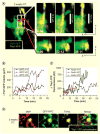Promoting remyelination: utilizing a viral model of demyelination to assess cell-based therapies
- PMID: 25245576
- PMCID: PMC4232205
- DOI: 10.1586/14737175.2014.955854
Promoting remyelination: utilizing a viral model of demyelination to assess cell-based therapies
Abstract
Multiple sclerosis (MS) is a chronic inflammatory disease of the CNS. While a broad range of therapeutics effectively reduce the incidence of focal white matter inflammation and plaque formation for patients with relapse-remitting forms of MS, a challenge within the field is to develop therapies that allow for axonal protection and remyelination. In the last decade, growing interest has focused on utilizing neural precursor cells (NPCs) to promote remyelination. To understand how NPCs function in chronic demyelinating environments, several excellent pre-clinical mouse models have been developed. One well accepted model is infection of susceptible mice with neurotropic variants of mouse hepatitis virus (MHV) that undergo chronic demyelination exhibiting clinical and histopathologic similarities to MS patients. Combined with the possibility that an environmental agent such as a virus could trigger MS, the MHV model of demyelination presents a relevant mouse model to assess the therapeutic potential of NPCs transplanted into an environment in which inflammatory-mediated demyelination is established.
Keywords: demyelination; multiple sclerosis; neural precursor cells; neural progenitor cells; remyelination; virus.
Figures



Similar articles
-
Two-photon imaging of remyelination of spinal cord axons by engrafted neural precursor cells in a viral model of multiple sclerosis.Proc Natl Acad Sci U S A. 2014 Jun 3;111(22):E2349-55. doi: 10.1073/pnas.1406658111. Epub 2014 May 19. Proc Natl Acad Sci U S A. 2014. PMID: 24843159 Free PMC article.
-
Promoting remyelination through cell transplantation therapies in a model of viral-induced neurodegenerative disease.Dev Dyn. 2019 Jan;248(1):43-52. doi: 10.1002/dvdy.24658. Epub 2018 Sep 6. Dev Dyn. 2019. PMID: 30067309 Free PMC article. Review.
-
iPSC-derived neural precursors exert a neuroprotective role in immune-mediated demyelination via the secretion of LIF.Nat Commun. 2013;4:2597. doi: 10.1038/ncomms3597. Nat Commun. 2013. PMID: 24169527
-
Cell replacement therapies to promote remyelination in a viral model of demyelination.J Neuroimmunol. 2010 Jul 27;224(1-2):101-7. doi: 10.1016/j.jneuroim.2010.05.013. Epub 2010 Jun 2. J Neuroimmunol. 2010. PMID: 20627412 Free PMC article. Review.
-
Remyelination Is Correlated with Regulatory T Cell Induction Following Human Embryoid Body-Derived Neural Precursor Cell Transplantation in a Viral Model of Multiple Sclerosis.PLoS One. 2016 Jun 16;11(6):e0157620. doi: 10.1371/journal.pone.0157620. eCollection 2016. PLoS One. 2016. PMID: 27310015 Free PMC article.
Cited by
-
Pharmacological approaches to intervention in hypomyelinating and demyelinating white matter pathology.Neuropharmacology. 2016 Nov;110(Pt B):605-625. doi: 10.1016/j.neuropharm.2015.06.008. Epub 2015 Jun 24. Neuropharmacology. 2016. PMID: 26116759 Free PMC article. Review.
-
Single-Cell RNA Sequencing Reveals the Diversity of the Immunological Landscape following Central Nervous System Infection by a Murine Coronavirus.J Virol. 2020 Nov 23;94(24):e01295-20. doi: 10.1128/JVI.01295-20. Print 2020 Nov 23. J Virol. 2020. PMID: 32999036 Free PMC article.
-
Chemokine CXCL10 and Coronavirus-Induced Neurologic Disease.Viral Immunol. 2019 Jan/Feb;32(1):25-37. doi: 10.1089/vim.2018.0073. Epub 2018 Aug 15. Viral Immunol. 2019. PMID: 30109979 Free PMC article. Review.
-
Viruses and Multiple Sclerosis: From Mechanisms and Pathways to Translational Research Opportunities.Mol Neurobiol. 2017 Jul;54(5):3911-3923. doi: 10.1007/s12035-017-0530-6. Epub 2017 Apr 28. Mol Neurobiol. 2017. PMID: 28455696 Review.
References
-
- Gage FH. Mammalian neural stem cells. Science. 2000;287(5457):1433–8. - PubMed
-
- Temple S. Division and differentiation of isolated CNS blast cells in microculture. Nature. 1989;340(6233):471–3. - PubMed
-
- Reynolds BA, Weiss S. Generation of neurons and astrocytes from isolated cells of the adult mammalian central nervous system. Science. 1992;255(5052):1707–10. - PubMed
-
- Brustle O, Jones KN, Learish RD, et al. Embryonic stem cell-derived glial precursors: a source of myelinating transplants. Science. 1999;285(5428):754–6. - PubMed
-
- Barberi T, Klivenyi P, Calingasan NY, et al. Neural subtype specification of fertilization and nuclear transfer embryonic stem cells and application in parkinsonian mice. Nat Biotechnol. 2003;21(10):1200–7. - PubMed
Publication types
MeSH terms
Grants and funding
LinkOut - more resources
Full Text Sources
Other Literature Sources
Medical
Molecular Biology Databases
